Issues in Language Acquisition and Learning
VerifiedAdded on 2023/03/30
|12
|2700
|426
AI Summary
This essay explores the concept of the critical period in second language acquisition and its impact on ultimate attainment. It discusses the different perspectives and theories surrounding this topic, including the age-length of the critical period, the setting in which it applies, and the areas of language that are affected. The essay also presents arguments for and against the critical period theory and provides a personal opinion on the matter.
Contribute Materials
Your contribution can guide someone’s learning journey. Share your
documents today.
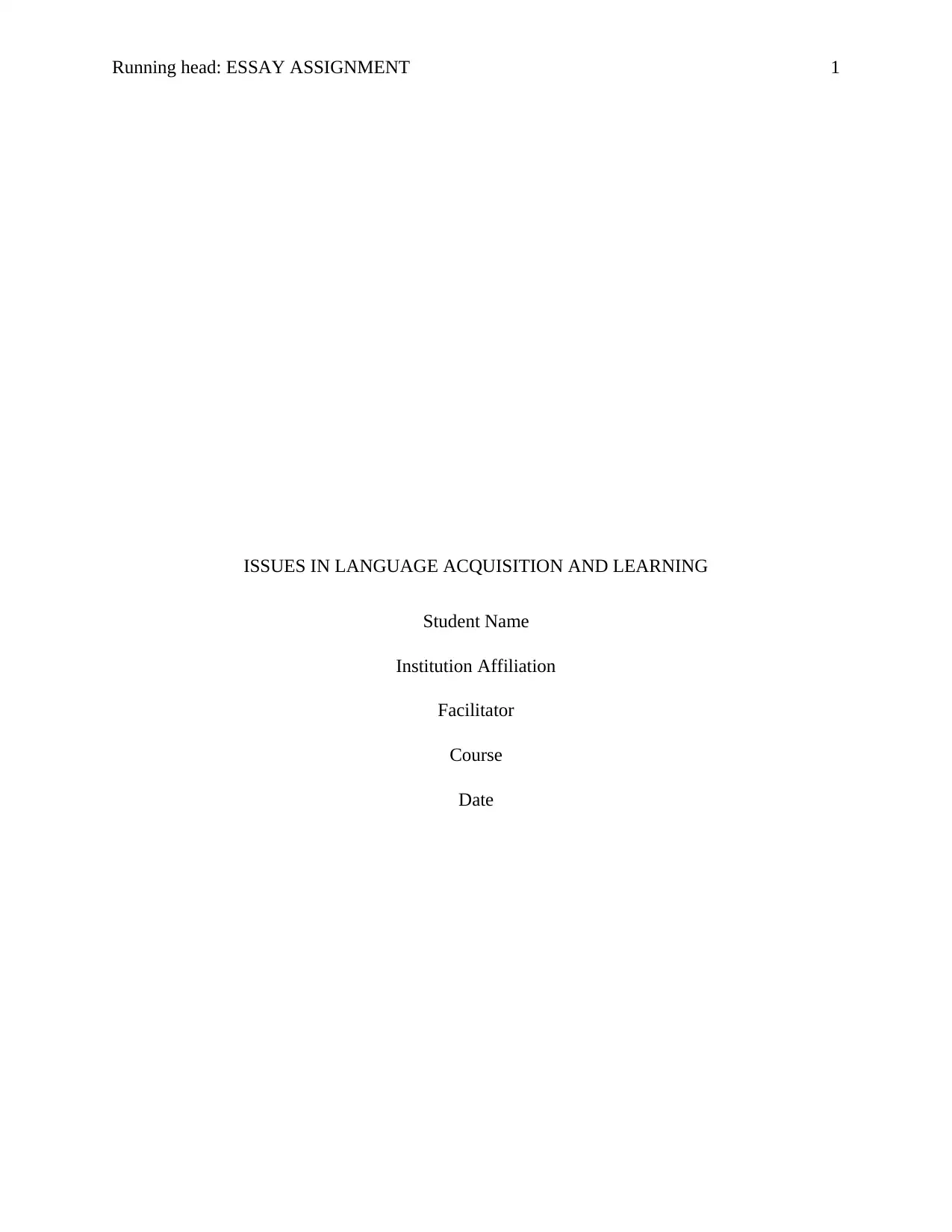
Running head: ESSAY ASSIGNMENT 1
ISSUES IN LANGUAGE ACQUISITION AND LEARNING
Student Name
Institution Affiliation
Facilitator
Course
Date
ISSUES IN LANGUAGE ACQUISITION AND LEARNING
Student Name
Institution Affiliation
Facilitator
Course
Date
Secure Best Marks with AI Grader
Need help grading? Try our AI Grader for instant feedback on your assignments.
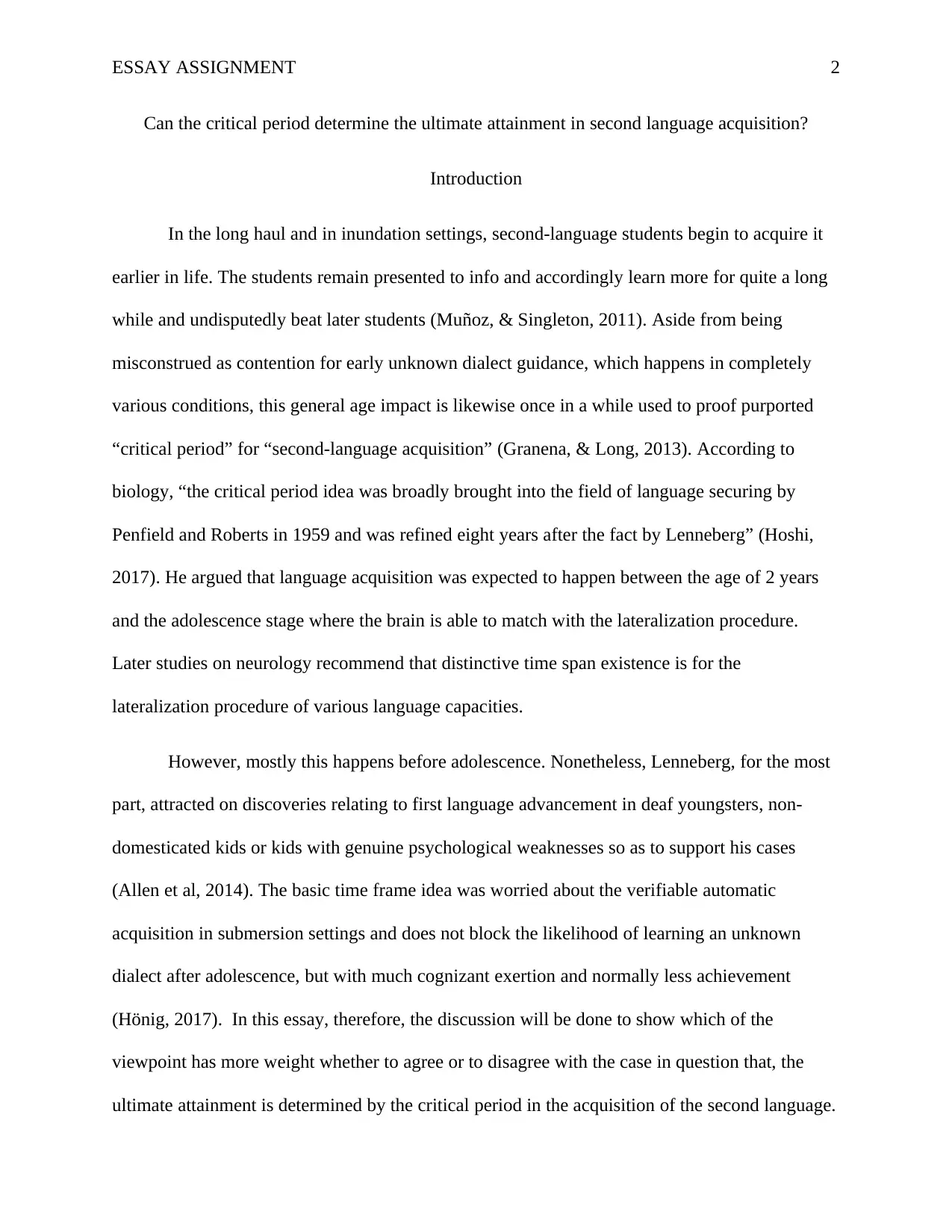
ESSAY ASSIGNMENT 2
Can the critical period determine the ultimate attainment in second language acquisition?
Introduction
In the long haul and in inundation settings, second-language students begin to acquire it
earlier in life. The students remain presented to info and accordingly learn more for quite a long
while and undisputedly beat later students (Muñoz, & Singleton, 2011). Aside from being
misconstrued as contention for early unknown dialect guidance, which happens in completely
various conditions, this general age impact is likewise once in a while used to proof purported
“critical period” for “second-language acquisition” (Granena, & Long, 2013). According to
biology, “the critical period idea was broadly brought into the field of language securing by
Penfield and Roberts in 1959 and was refined eight years after the fact by Lenneberg” (Hoshi,
2017). He argued that language acquisition was expected to happen between the age of 2 years
and the adolescence stage where the brain is able to match with the lateralization procedure.
Later studies on neurology recommend that distinctive time span existence is for the
lateralization procedure of various language capacities.
However, mostly this happens before adolescence. Nonetheless, Lenneberg, for the most
part, attracted on discoveries relating to first language advancement in deaf youngsters, non-
domesticated kids or kids with genuine psychological weaknesses so as to support his cases
(Allen et al, 2014). The basic time frame idea was worried about the verifiable automatic
acquisition in submersion settings and does not block the likelihood of learning an unknown
dialect after adolescence, but with much cognizant exertion and normally less achievement
(Hönig, 2017). In this essay, therefore, the discussion will be done to show which of the
viewpoint has more weight whether to agree or to disagree with the case in question that, the
ultimate attainment is determined by the critical period in the acquisition of the second language.
Can the critical period determine the ultimate attainment in second language acquisition?
Introduction
In the long haul and in inundation settings, second-language students begin to acquire it
earlier in life. The students remain presented to info and accordingly learn more for quite a long
while and undisputedly beat later students (Muñoz, & Singleton, 2011). Aside from being
misconstrued as contention for early unknown dialect guidance, which happens in completely
various conditions, this general age impact is likewise once in a while used to proof purported
“critical period” for “second-language acquisition” (Granena, & Long, 2013). According to
biology, “the critical period idea was broadly brought into the field of language securing by
Penfield and Roberts in 1959 and was refined eight years after the fact by Lenneberg” (Hoshi,
2017). He argued that language acquisition was expected to happen between the age of 2 years
and the adolescence stage where the brain is able to match with the lateralization procedure.
Later studies on neurology recommend that distinctive time span existence is for the
lateralization procedure of various language capacities.
However, mostly this happens before adolescence. Nonetheless, Lenneberg, for the most
part, attracted on discoveries relating to first language advancement in deaf youngsters, non-
domesticated kids or kids with genuine psychological weaknesses so as to support his cases
(Allen et al, 2014). The basic time frame idea was worried about the verifiable automatic
acquisition in submersion settings and does not block the likelihood of learning an unknown
dialect after adolescence, but with much cognizant exertion and normally less achievement
(Hönig, 2017). In this essay, therefore, the discussion will be done to show which of the
viewpoint has more weight whether to agree or to disagree with the case in question that, the
ultimate attainment is determined by the critical period in the acquisition of the second language.
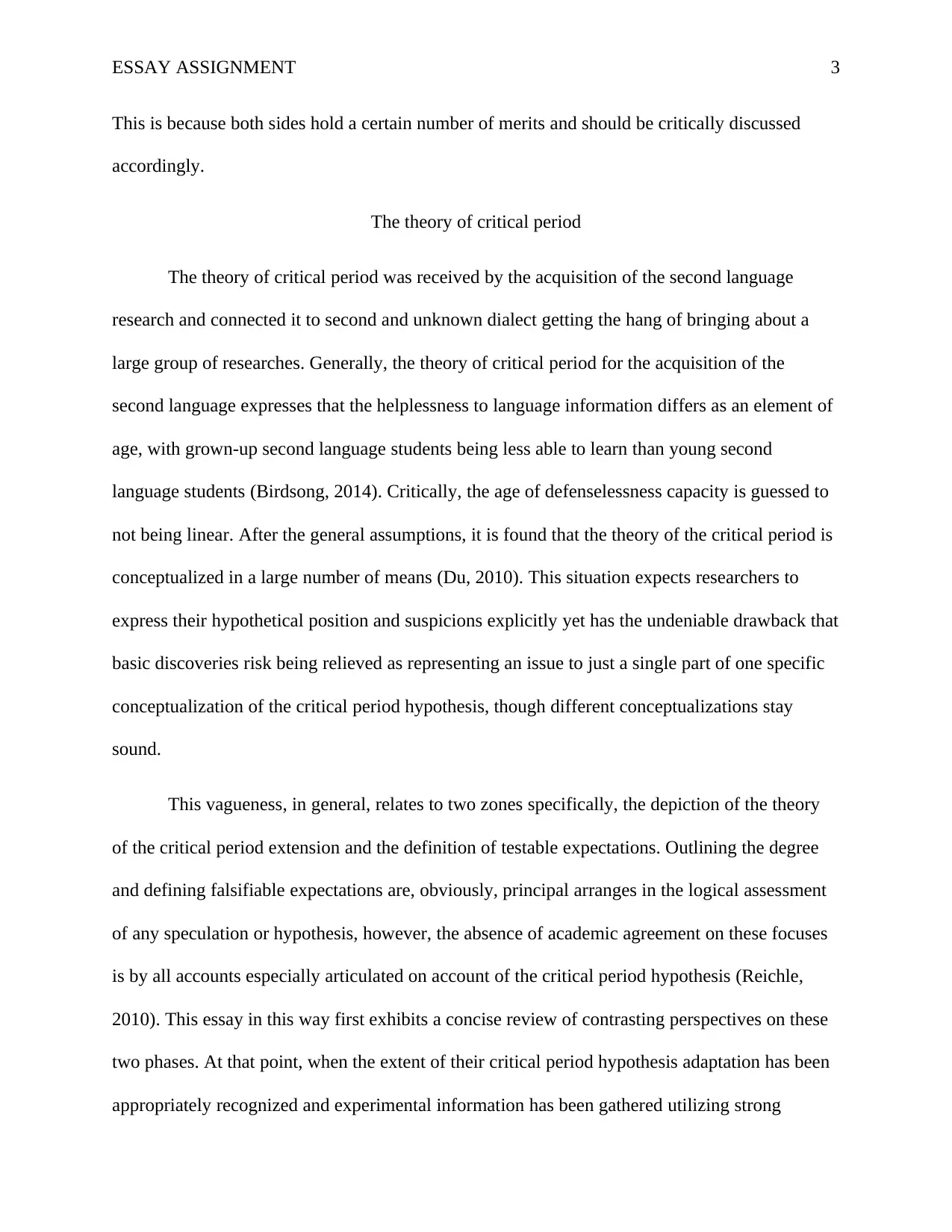
ESSAY ASSIGNMENT 3
This is because both sides hold a certain number of merits and should be critically discussed
accordingly.
The theory of critical period
The theory of critical period was received by the acquisition of the second language
research and connected it to second and unknown dialect getting the hang of bringing about a
large group of researches. Generally, the theory of critical period for the acquisition of the
second language expresses that the helplessness to language information differs as an element of
age, with grown-up second language students being less able to learn than young second
language students (Birdsong, 2014). Critically, the age of defenselessness capacity is guessed to
not being linear. After the general assumptions, it is found that the theory of the critical period is
conceptualized in a large number of means (Du, 2010). This situation expects researchers to
express their hypothetical position and suspicions explicitly yet has the undeniable drawback that
basic discoveries risk being relieved as representing an issue to just a single part of one specific
conceptualization of the critical period hypothesis, though different conceptualizations stay
sound.
This vagueness, in general, relates to two zones specifically, the depiction of the theory
of the critical period extension and the definition of testable expectations. Outlining the degree
and defining falsifiable expectations are, obviously, principal arranges in the logical assessment
of any speculation or hypothesis, however, the absence of academic agreement on these focuses
is by all accounts especially articulated on account of the critical period hypothesis (Reichle,
2010). This essay in this way first exhibits a concise review of contrasting perspectives on these
two phases. At that point, when the extent of their critical period hypothesis adaptation has been
appropriately recognized and experimental information has been gathered utilizing strong
This is because both sides hold a certain number of merits and should be critically discussed
accordingly.
The theory of critical period
The theory of critical period was received by the acquisition of the second language
research and connected it to second and unknown dialect getting the hang of bringing about a
large group of researches. Generally, the theory of critical period for the acquisition of the
second language expresses that the helplessness to language information differs as an element of
age, with grown-up second language students being less able to learn than young second
language students (Birdsong, 2014). Critically, the age of defenselessness capacity is guessed to
not being linear. After the general assumptions, it is found that the theory of the critical period is
conceptualized in a large number of means (Du, 2010). This situation expects researchers to
express their hypothetical position and suspicions explicitly yet has the undeniable drawback that
basic discoveries risk being relieved as representing an issue to just a single part of one specific
conceptualization of the critical period hypothesis, though different conceptualizations stay
sound.
This vagueness, in general, relates to two zones specifically, the depiction of the theory
of the critical period extension and the definition of testable expectations. Outlining the degree
and defining falsifiable expectations are, obviously, principal arranges in the logical assessment
of any speculation or hypothesis, however, the absence of academic agreement on these focuses
is by all accounts especially articulated on account of the critical period hypothesis (Reichle,
2010). This essay in this way first exhibits a concise review of contrasting perspectives on these
two phases. At that point, when the extent of their critical period hypothesis adaptation has been
appropriately recognized and experimental information has been gathered utilizing strong

ESSAY ASSIGNMENT 4
techniques. It is fundamental that analysts break down the information designs perfectly so as to
survey the expectations made and that they make legitimate inferences from the outcomes.
Portraying the extent of the critical period theory
To begin with, for a putative basic term for the acquisition of language the age-length has
been reviewed in different writings by different authors. The basic period extended from 2 years
of age to adolescence placed at around 14 years old according to Lenneberg, though different
researchers have suggested the cutoff point between 12 and 18 years (Muñoz, & Singleton,
2011). Not at all like Lenneberg, most scientists recently don't characterize a beginning age for
the basic time frame for the learning of a language. A few, nonetheless, think about the basic
time frame or a basic period for a particular language zone, for example, phonology finishing a
lot sooner than pubescence for example at age of 9 years, or as ahead of schedule as a year on
account of phonology (Vanhove, 2013).
Secondly, some dubiousness stays with regards to the setting that is significant to the
critical period hypothesis. Does the basic time frame compel understood learning forms alone?
For example, is untrained language obtaining in submersion settings or it additionally applies to
trained learning? Many specialists concur on the previous, but the examination has used persons
who have had probably some guidance in the second language acquisition.
Thirdly, no accord is present on what the extent of the basic time frame is similarly as the
zones of language in the association. Most specialists concur that a critical period is destined to
oblige the securing of elocution and sentence structure and, thusly, these are the territories
principally investigated in reviews on the critical period theory. A few scientists have
techniques. It is fundamental that analysts break down the information designs perfectly so as to
survey the expectations made and that they make legitimate inferences from the outcomes.
Portraying the extent of the critical period theory
To begin with, for a putative basic term for the acquisition of language the age-length has
been reviewed in different writings by different authors. The basic period extended from 2 years
of age to adolescence placed at around 14 years old according to Lenneberg, though different
researchers have suggested the cutoff point between 12 and 18 years (Muñoz, & Singleton,
2011). Not at all like Lenneberg, most scientists recently don't characterize a beginning age for
the basic time frame for the learning of a language. A few, nonetheless, think about the basic
time frame or a basic period for a particular language zone, for example, phonology finishing a
lot sooner than pubescence for example at age of 9 years, or as ahead of schedule as a year on
account of phonology (Vanhove, 2013).
Secondly, some dubiousness stays with regards to the setting that is significant to the
critical period hypothesis. Does the basic time frame compel understood learning forms alone?
For example, is untrained language obtaining in submersion settings or it additionally applies to
trained learning? Many specialists concur on the previous, but the examination has used persons
who have had probably some guidance in the second language acquisition.
Thirdly, no accord is present on what the extent of the basic time frame is similarly as the
zones of language in the association. Most specialists concur that a critical period is destined to
oblige the securing of elocution and sentence structure and, thusly, these are the territories
principally investigated in reviews on the critical period theory. A few scientists have
Secure Best Marks with AI Grader
Need help grading? Try our AI Grader for instant feedback on your assignments.
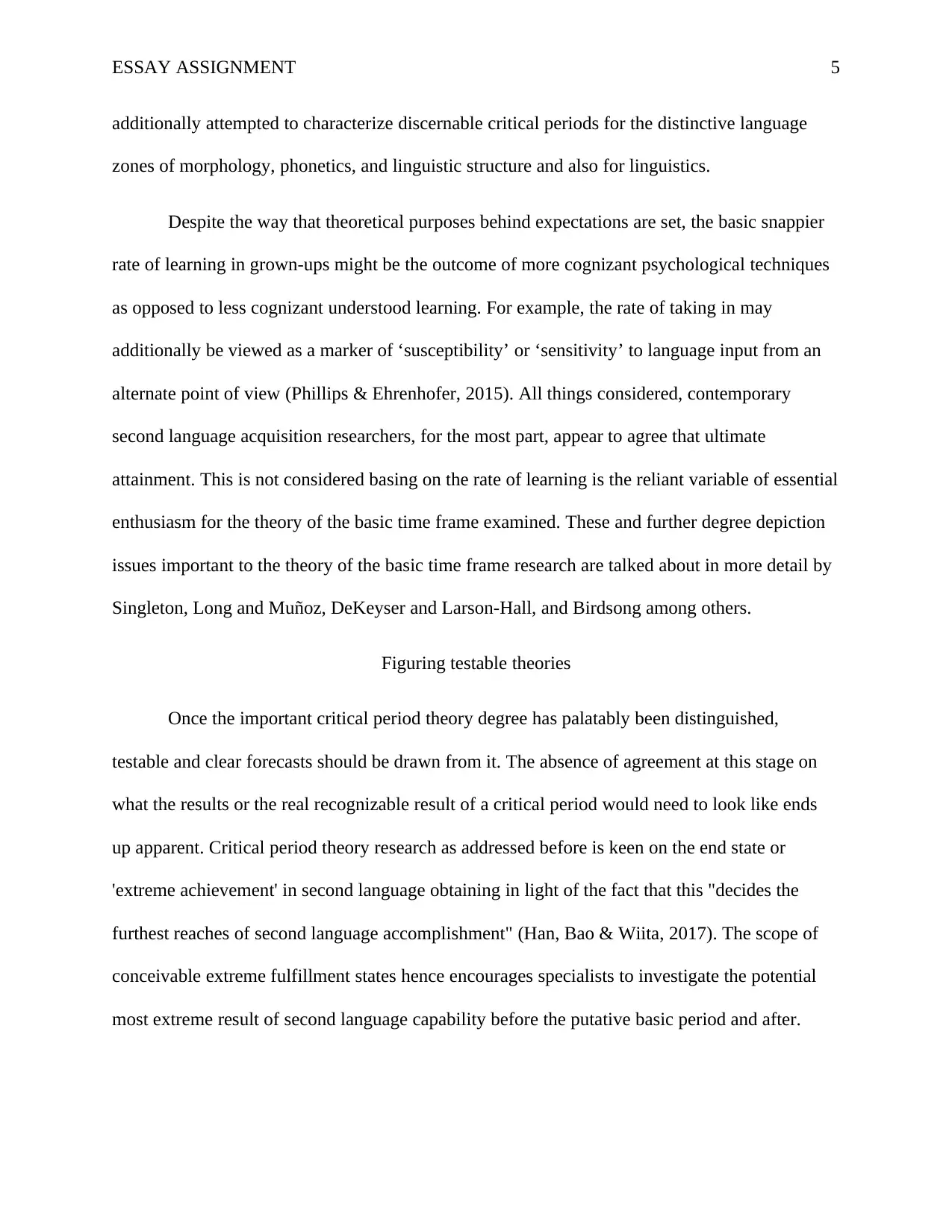
ESSAY ASSIGNMENT 5
additionally attempted to characterize discernable critical periods for the distinctive language
zones of morphology, phonetics, and linguistic structure and also for linguistics.
Despite the way that theoretical purposes behind expectations are set, the basic snappier
rate of learning in grown-ups might be the outcome of more cognizant psychological techniques
as opposed to less cognizant understood learning. For example, the rate of taking in may
additionally be viewed as a marker of ‘susceptibility’ or ‘sensitivity’ to language input from an
alternate point of view (Phillips & Ehrenhofer, 2015). All things considered, contemporary
second language acquisition researchers, for the most part, appear to agree that ultimate
attainment. This is not considered basing on the rate of learning is the reliant variable of essential
enthusiasm for the theory of the basic time frame examined. These and further degree depiction
issues important to the theory of the basic time frame research are talked about in more detail by
Singleton, Long and Muñoz, DeKeyser and Larson-Hall, and Birdsong among others.
Figuring testable theories
Once the important critical period theory degree has palatably been distinguished,
testable and clear forecasts should be drawn from it. The absence of agreement at this stage on
what the results or the real recognizable result of a critical period would need to look like ends
up apparent. Critical period theory research as addressed before is keen on the end state or
'extreme achievement' in second language obtaining in light of the fact that this "decides the
furthest reaches of second language accomplishment" (Han, Bao & Wiita, 2017). The scope of
conceivable extreme fulfillment states hence encourages specialists to investigate the potential
most extreme result of second language capability before the putative basic period and after.
additionally attempted to characterize discernable critical periods for the distinctive language
zones of morphology, phonetics, and linguistic structure and also for linguistics.
Despite the way that theoretical purposes behind expectations are set, the basic snappier
rate of learning in grown-ups might be the outcome of more cognizant psychological techniques
as opposed to less cognizant understood learning. For example, the rate of taking in may
additionally be viewed as a marker of ‘susceptibility’ or ‘sensitivity’ to language input from an
alternate point of view (Phillips & Ehrenhofer, 2015). All things considered, contemporary
second language acquisition researchers, for the most part, appear to agree that ultimate
attainment. This is not considered basing on the rate of learning is the reliant variable of essential
enthusiasm for the theory of the basic time frame examined. These and further degree depiction
issues important to the theory of the basic time frame research are talked about in more detail by
Singleton, Long and Muñoz, DeKeyser and Larson-Hall, and Birdsong among others.
Figuring testable theories
Once the important critical period theory degree has palatably been distinguished,
testable and clear forecasts should be drawn from it. The absence of agreement at this stage on
what the results or the real recognizable result of a critical period would need to look like ends
up apparent. Critical period theory research as addressed before is keen on the end state or
'extreme achievement' in second language obtaining in light of the fact that this "decides the
furthest reaches of second language accomplishment" (Han, Bao & Wiita, 2017). The scope of
conceivable extreme fulfillment states hence encourages specialists to investigate the potential
most extreme result of second language capability before the putative basic period and after.
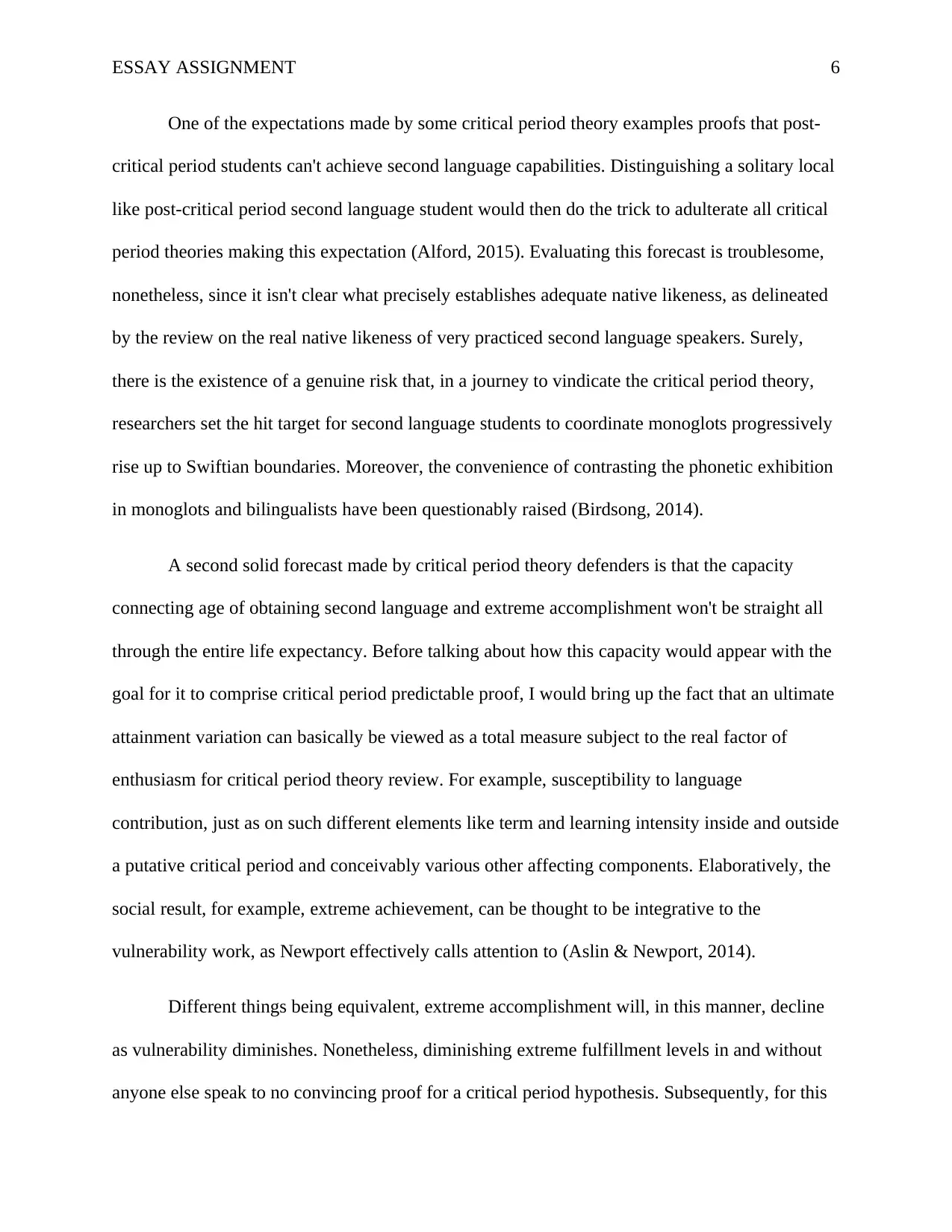
ESSAY ASSIGNMENT 6
One of the expectations made by some critical period theory examples proofs that post-
critical period students can't achieve second language capabilities. Distinguishing a solitary local
like post-critical period second language student would then do the trick to adulterate all critical
period theories making this expectation (Alford, 2015). Evaluating this forecast is troublesome,
nonetheless, since it isn't clear what precisely establishes adequate native likeness, as delineated
by the review on the real native likeness of very practiced second language speakers. Surely,
there is the existence of a genuine risk that, in a journey to vindicate the critical period theory,
researchers set the hit target for second language students to coordinate monoglots progressively
rise up to Swiftian boundaries. Moreover, the convenience of contrasting the phonetic exhibition
in monoglots and bilingualists have been questionably raised (Birdsong, 2014).
A second solid forecast made by critical period theory defenders is that the capacity
connecting age of obtaining second language and extreme accomplishment won't be straight all
through the entire life expectancy. Before talking about how this capacity would appear with the
goal for it to comprise critical period predictable proof, I would bring up the fact that an ultimate
attainment variation can basically be viewed as a total measure subject to the real factor of
enthusiasm for critical period theory review. For example, susceptibility to language
contribution, just as on such different elements like term and learning intensity inside and outside
a putative critical period and conceivably various other affecting components. Elaboratively, the
social result, for example, extreme achievement, can be thought to be integrative to the
vulnerability work, as Newport effectively calls attention to (Aslin & Newport, 2014).
Different things being equivalent, extreme accomplishment will, in this manner, decline
as vulnerability diminishes. Nonetheless, diminishing extreme fulfillment levels in and without
anyone else speak to no convincing proof for a critical period hypothesis. Subsequently, for this
One of the expectations made by some critical period theory examples proofs that post-
critical period students can't achieve second language capabilities. Distinguishing a solitary local
like post-critical period second language student would then do the trick to adulterate all critical
period theories making this expectation (Alford, 2015). Evaluating this forecast is troublesome,
nonetheless, since it isn't clear what precisely establishes adequate native likeness, as delineated
by the review on the real native likeness of very practiced second language speakers. Surely,
there is the existence of a genuine risk that, in a journey to vindicate the critical period theory,
researchers set the hit target for second language students to coordinate monoglots progressively
rise up to Swiftian boundaries. Moreover, the convenience of contrasting the phonetic exhibition
in monoglots and bilingualists have been questionably raised (Birdsong, 2014).
A second solid forecast made by critical period theory defenders is that the capacity
connecting age of obtaining second language and extreme accomplishment won't be straight all
through the entire life expectancy. Before talking about how this capacity would appear with the
goal for it to comprise critical period predictable proof, I would bring up the fact that an ultimate
attainment variation can basically be viewed as a total measure subject to the real factor of
enthusiasm for critical period theory review. For example, susceptibility to language
contribution, just as on such different elements like term and learning intensity inside and outside
a putative critical period and conceivably various other affecting components. Elaboratively, the
social result, for example, extreme achievement, can be thought to be integrative to the
vulnerability work, as Newport effectively calls attention to (Aslin & Newport, 2014).
Different things being equivalent, extreme accomplishment will, in this manner, decline
as vulnerability diminishes. Nonetheless, diminishing extreme fulfillment levels in and without
anyone else speak to no convincing proof for a critical period hypothesis. Subsequently, for this

ESSAY ASSIGNMENT 7
type of integrative bend, the anticipation should be unmistakable from the susceptibility function.
Furthermore, “the age of acquisition ultimate attainment function can take just about any form
when other things are not equal” (DeKeyser, 2013). For example, for the length of studying the
new language, does it remain till the time of getting tested or for quite some years or does it
depend on age? For the strength of studying the new language, do students learn it at their
highest level of weakness or does this pressure depend on term, age, inspiration or present
satisfaction? The susceptibility capacity indispensability could, subsequently, be essential of
boundless multifaceted nature and its parameters can be changed in accordance to “fit any age of
acquisition-ultimate attainment pattern” (Flecken, 2011).
A personal opinion on the critical period
As an experienced teacher, my own opinion in regards to the acquisition of the second
language is agreeing with the fact that age cannot be a determinant. In regards to Noam
Chomsky, acquiring a new language or second language is something in the brain from birth or
else innate. In 1977 he proposed that “all children share the same internal constraints which
characterize narrowly the grammar they are going to construct” (Dahl, & Miralles, 2012). And
hence he trusts it can also be achieved to a given age. According to Piaget’s steps of cognitive
development, it is true that different stages of childhood can help one to master different skills as
they grow but 11 years and above is better for language acquisition.
I agree with Piaget’s concept because different people either 11 years or older have
different capabilities of acquiring a language. In cognitive development, this formal operational
stage is when most learn reasoning and abstract logic, counterfactual thoughts and theoretical
knowledge. According to Lev Vygotsky, it is stated that the acquisition of new knowledge like a
second language is highly influenced by an external force. For instance, on my behalf as a
type of integrative bend, the anticipation should be unmistakable from the susceptibility function.
Furthermore, “the age of acquisition ultimate attainment function can take just about any form
when other things are not equal” (DeKeyser, 2013). For example, for the length of studying the
new language, does it remain till the time of getting tested or for quite some years or does it
depend on age? For the strength of studying the new language, do students learn it at their
highest level of weakness or does this pressure depend on term, age, inspiration or present
satisfaction? The susceptibility capacity indispensability could, subsequently, be essential of
boundless multifaceted nature and its parameters can be changed in accordance to “fit any age of
acquisition-ultimate attainment pattern” (Flecken, 2011).
A personal opinion on the critical period
As an experienced teacher, my own opinion in regards to the acquisition of the second
language is agreeing with the fact that age cannot be a determinant. In regards to Noam
Chomsky, acquiring a new language or second language is something in the brain from birth or
else innate. In 1977 he proposed that “all children share the same internal constraints which
characterize narrowly the grammar they are going to construct” (Dahl, & Miralles, 2012). And
hence he trusts it can also be achieved to a given age. According to Piaget’s steps of cognitive
development, it is true that different stages of childhood can help one to master different skills as
they grow but 11 years and above is better for language acquisition.
I agree with Piaget’s concept because different people either 11 years or older have
different capabilities of acquiring a language. In cognitive development, this formal operational
stage is when most learn reasoning and abstract logic, counterfactual thoughts and theoretical
knowledge. According to Lev Vygotsky, it is stated that the acquisition of new knowledge like a
second language is highly influenced by an external force. For instance, on my behalf as a
Paraphrase This Document
Need a fresh take? Get an instant paraphrase of this document with our AI Paraphraser

ESSAY ASSIGNMENT 8
learner it seems possible like for the case of English, it is easier to learn when someone else is
helping or teaching you. So conclusively despite the contradictions brought about by Piaget and
Vygotsky, my stand is second language acquisition is not dependent on the critical period but
rather on the influence of the teacher or the understanding capability and it might change from an
individual to another (Blake, 2015).
The investigation into the theory of the critical period has concentrated on ultimate
attainment or the last state of second language capability as opposed to the rate of learning.
According to researches investigation into the rate of acquisition, it has turned out to be evident
that the theory of critical period can't sustain rate variability. Truth be told, it is evident that
grown-up students continue quicker than young students toward the starting phases of the second
language securing. A solid negative connection between the ultimate attainment and the age of
acquisition all through the life expectancy, the main age impact archived in numerous previous
examinations, isn't confirmed for a basic time frame. The basic time frame idea infers a break in
the age of onset of acquisition capability function. For instance, an age to some degree variable
from person to person, obviously, and in this manner, an age go totally after which the decrease
of accomplishment rate in at least one region of language is significantly less articulated as well
as unmistakably because of various reasons.
Conclusion
In conclusion, as has been shown in this essay, that the acquisition of the second
language and the theory of vital time frame holds no capacity between students' years and their
powerlessness to learning a second language. This essay has returned to the vagary found in the
writing as to this present speculation's degree and forecasts. Notwithstanding when its degree is
unmistakably portrayed and its expectations are clearly put, nonetheless, observational
learner it seems possible like for the case of English, it is easier to learn when someone else is
helping or teaching you. So conclusively despite the contradictions brought about by Piaget and
Vygotsky, my stand is second language acquisition is not dependent on the critical period but
rather on the influence of the teacher or the understanding capability and it might change from an
individual to another (Blake, 2015).
The investigation into the theory of the critical period has concentrated on ultimate
attainment or the last state of second language capability as opposed to the rate of learning.
According to researches investigation into the rate of acquisition, it has turned out to be evident
that the theory of critical period can't sustain rate variability. Truth be told, it is evident that
grown-up students continue quicker than young students toward the starting phases of the second
language securing. A solid negative connection between the ultimate attainment and the age of
acquisition all through the life expectancy, the main age impact archived in numerous previous
examinations, isn't confirmed for a basic time frame. The basic time frame idea infers a break in
the age of onset of acquisition capability function. For instance, an age to some degree variable
from person to person, obviously, and in this manner, an age go totally after which the decrease
of accomplishment rate in at least one region of language is significantly less articulated as well
as unmistakably because of various reasons.
Conclusion
In conclusion, as has been shown in this essay, that the acquisition of the second
language and the theory of vital time frame holds no capacity between students' years and their
powerlessness to learning a second language. This essay has returned to the vagary found in the
writing as to this present speculation's degree and forecasts. Notwithstanding when its degree is
unmistakably portrayed and its expectations are clearly put, nonetheless, observational
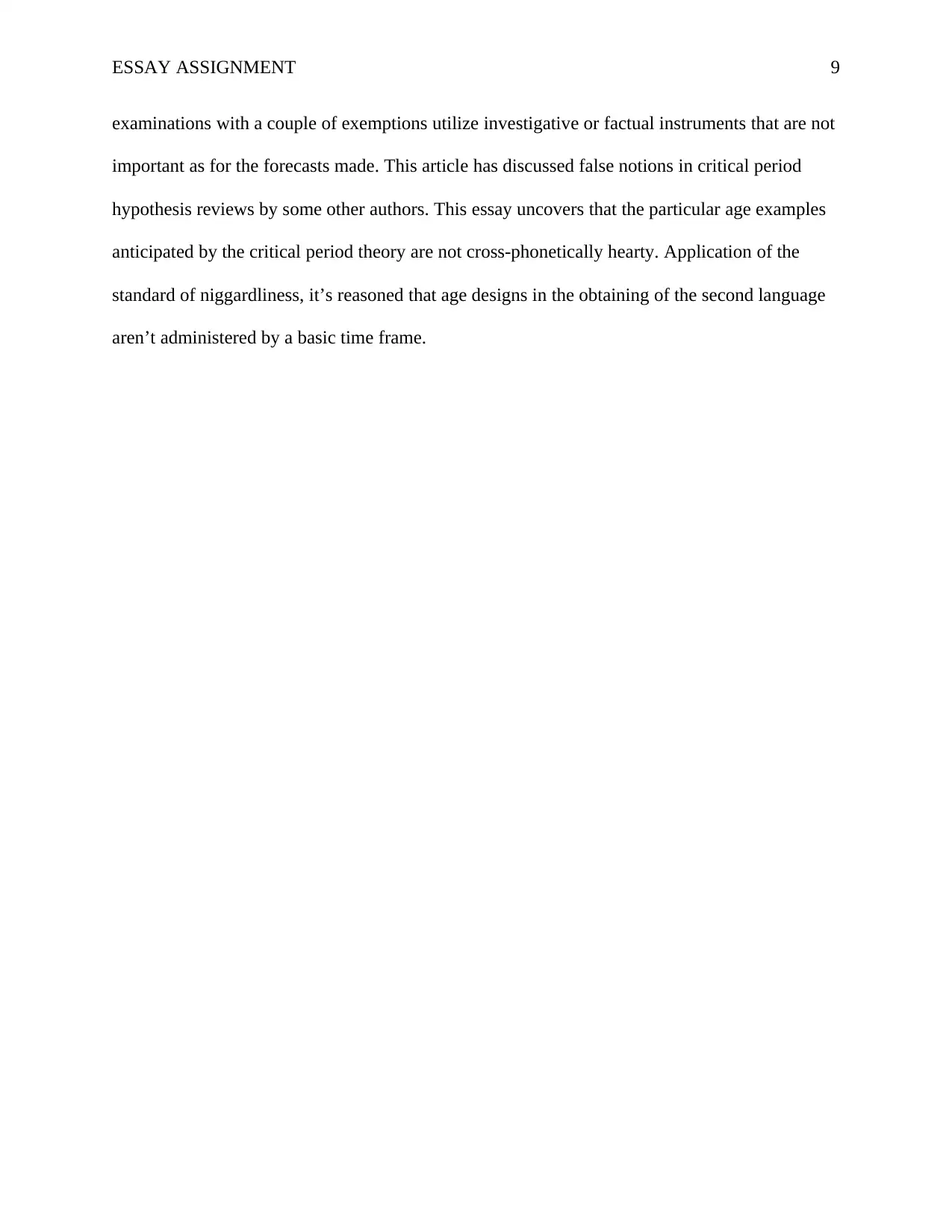
ESSAY ASSIGNMENT 9
examinations with a couple of exemptions utilize investigative or factual instruments that are not
important as for the forecasts made. This article has discussed false notions in critical period
hypothesis reviews by some other authors. This essay uncovers that the particular age examples
anticipated by the critical period theory are not cross-phonetically hearty. Application of the
standard of niggardliness, it’s reasoned that age designs in the obtaining of the second language
aren’t administered by a basic time frame.
examinations with a couple of exemptions utilize investigative or factual instruments that are not
important as for the forecasts made. This article has discussed false notions in critical period
hypothesis reviews by some other authors. This essay uncovers that the particular age examples
anticipated by the critical period theory are not cross-phonetically hearty. Application of the
standard of niggardliness, it’s reasoned that age designs in the obtaining of the second language
aren’t administered by a basic time frame.
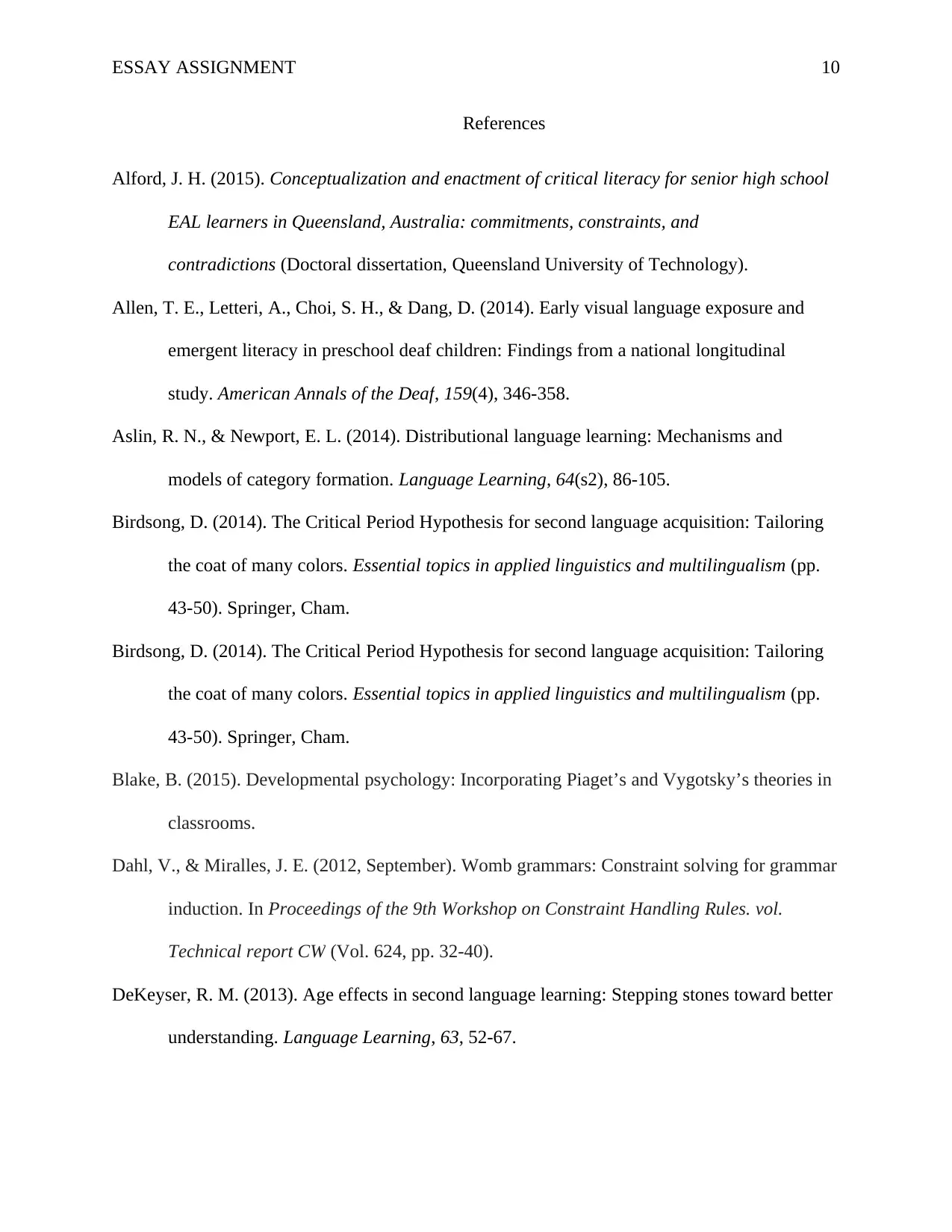
ESSAY ASSIGNMENT 10
References
Alford, J. H. (2015). Conceptualization and enactment of critical literacy for senior high school
EAL learners in Queensland, Australia: commitments, constraints, and
contradictions (Doctoral dissertation, Queensland University of Technology).
Allen, T. E., Letteri, A., Choi, S. H., & Dang, D. (2014). Early visual language exposure and
emergent literacy in preschool deaf children: Findings from a national longitudinal
study. American Annals of the Deaf, 159(4), 346-358.
Aslin, R. N., & Newport, E. L. (2014). Distributional language learning: Mechanisms and
models of category formation. Language Learning, 64(s2), 86-105.
Birdsong, D. (2014). The Critical Period Hypothesis for second language acquisition: Tailoring
the coat of many colors. Essential topics in applied linguistics and multilingualism (pp.
43-50). Springer, Cham.
Birdsong, D. (2014). The Critical Period Hypothesis for second language acquisition: Tailoring
the coat of many colors. Essential topics in applied linguistics and multilingualism (pp.
43-50). Springer, Cham.
Blake, B. (2015). Developmental psychology: Incorporating Piaget’s and Vygotsky’s theories in
classrooms.
Dahl, V., & Miralles, J. E. (2012, September). Womb grammars: Constraint solving for grammar
induction. In Proceedings of the 9th Workshop on Constraint Handling Rules. vol.
Technical report CW (Vol. 624, pp. 32-40).
DeKeyser, R. M. (2013). Age effects in second language learning: Stepping stones toward better
understanding. Language Learning, 63, 52-67.
References
Alford, J. H. (2015). Conceptualization and enactment of critical literacy for senior high school
EAL learners in Queensland, Australia: commitments, constraints, and
contradictions (Doctoral dissertation, Queensland University of Technology).
Allen, T. E., Letteri, A., Choi, S. H., & Dang, D. (2014). Early visual language exposure and
emergent literacy in preschool deaf children: Findings from a national longitudinal
study. American Annals of the Deaf, 159(4), 346-358.
Aslin, R. N., & Newport, E. L. (2014). Distributional language learning: Mechanisms and
models of category formation. Language Learning, 64(s2), 86-105.
Birdsong, D. (2014). The Critical Period Hypothesis for second language acquisition: Tailoring
the coat of many colors. Essential topics in applied linguistics and multilingualism (pp.
43-50). Springer, Cham.
Birdsong, D. (2014). The Critical Period Hypothesis for second language acquisition: Tailoring
the coat of many colors. Essential topics in applied linguistics and multilingualism (pp.
43-50). Springer, Cham.
Blake, B. (2015). Developmental psychology: Incorporating Piaget’s and Vygotsky’s theories in
classrooms.
Dahl, V., & Miralles, J. E. (2012, September). Womb grammars: Constraint solving for grammar
induction. In Proceedings of the 9th Workshop on Constraint Handling Rules. vol.
Technical report CW (Vol. 624, pp. 32-40).
DeKeyser, R. M. (2013). Age effects in second language learning: Stepping stones toward better
understanding. Language Learning, 63, 52-67.
Secure Best Marks with AI Grader
Need help grading? Try our AI Grader for instant feedback on your assignments.
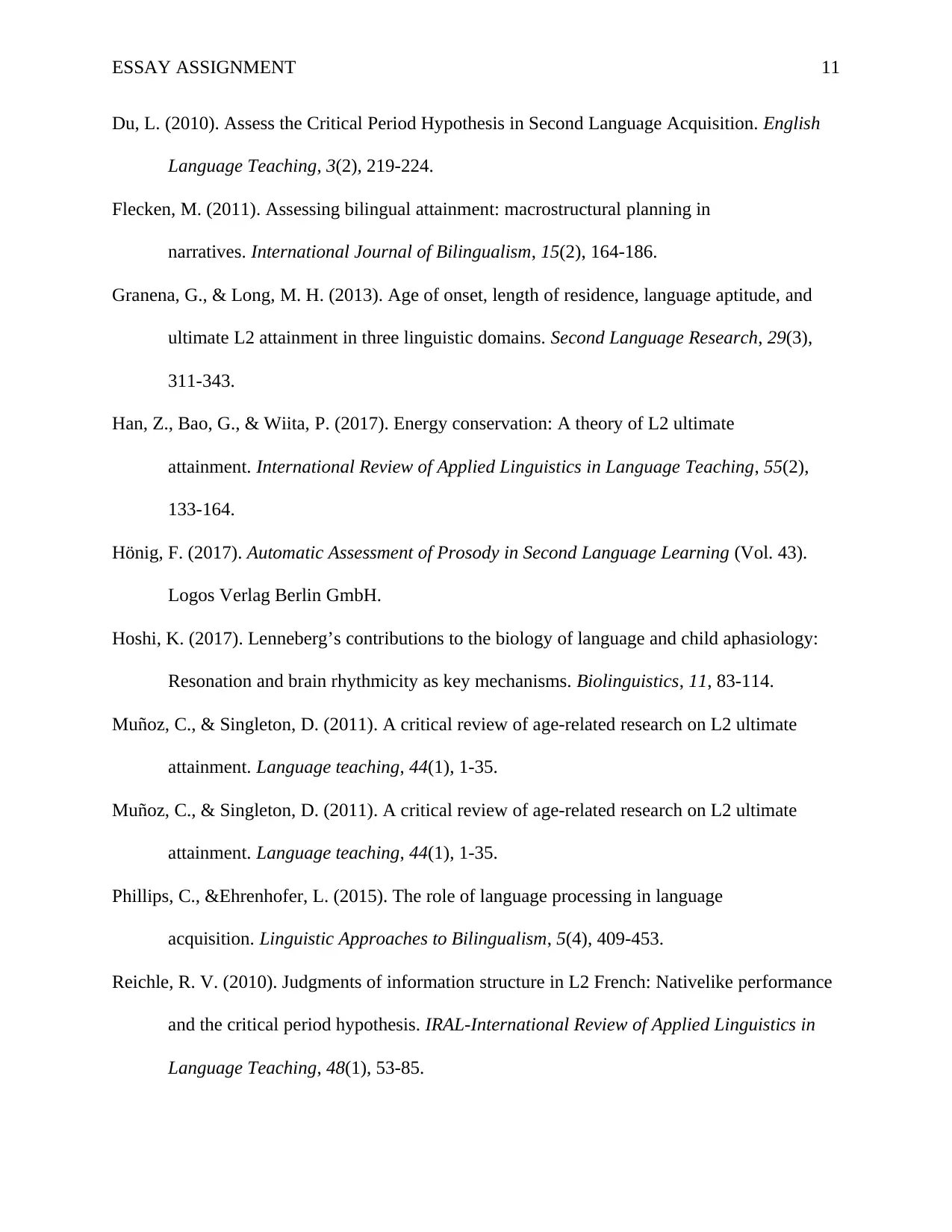
ESSAY ASSIGNMENT 11
Du, L. (2010). Assess the Critical Period Hypothesis in Second Language Acquisition. English
Language Teaching, 3(2), 219-224.
Flecken, M. (2011). Assessing bilingual attainment: macrostructural planning in
narratives. International Journal of Bilingualism, 15(2), 164-186.
Granena, G., & Long, M. H. (2013). Age of onset, length of residence, language aptitude, and
ultimate L2 attainment in three linguistic domains. Second Language Research, 29(3),
311-343.
Han, Z., Bao, G., & Wiita, P. (2017). Energy conservation: A theory of L2 ultimate
attainment. International Review of Applied Linguistics in Language Teaching, 55(2),
133-164.
Hönig, F. (2017). Automatic Assessment of Prosody in Second Language Learning (Vol. 43).
Logos Verlag Berlin GmbH.
Hoshi, K. (2017). Lenneberg’s contributions to the biology of language and child aphasiology:
Resonation and brain rhythmicity as key mechanisms. Biolinguistics, 11, 83-114.
Muñoz, C., & Singleton, D. (2011). A critical review of age-related research on L2 ultimate
attainment. Language teaching, 44(1), 1-35.
Muñoz, C., & Singleton, D. (2011). A critical review of age-related research on L2 ultimate
attainment. Language teaching, 44(1), 1-35.
Phillips, C., &Ehrenhofer, L. (2015). The role of language processing in language
acquisition. Linguistic Approaches to Bilingualism, 5(4), 409-453.
Reichle, R. V. (2010). Judgments of information structure in L2 French: Nativelike performance
and the critical period hypothesis. IRAL-International Review of Applied Linguistics in
Language Teaching, 48(1), 53-85.
Du, L. (2010). Assess the Critical Period Hypothesis in Second Language Acquisition. English
Language Teaching, 3(2), 219-224.
Flecken, M. (2011). Assessing bilingual attainment: macrostructural planning in
narratives. International Journal of Bilingualism, 15(2), 164-186.
Granena, G., & Long, M. H. (2013). Age of onset, length of residence, language aptitude, and
ultimate L2 attainment in three linguistic domains. Second Language Research, 29(3),
311-343.
Han, Z., Bao, G., & Wiita, P. (2017). Energy conservation: A theory of L2 ultimate
attainment. International Review of Applied Linguistics in Language Teaching, 55(2),
133-164.
Hönig, F. (2017). Automatic Assessment of Prosody in Second Language Learning (Vol. 43).
Logos Verlag Berlin GmbH.
Hoshi, K. (2017). Lenneberg’s contributions to the biology of language and child aphasiology:
Resonation and brain rhythmicity as key mechanisms. Biolinguistics, 11, 83-114.
Muñoz, C., & Singleton, D. (2011). A critical review of age-related research on L2 ultimate
attainment. Language teaching, 44(1), 1-35.
Muñoz, C., & Singleton, D. (2011). A critical review of age-related research on L2 ultimate
attainment. Language teaching, 44(1), 1-35.
Phillips, C., &Ehrenhofer, L. (2015). The role of language processing in language
acquisition. Linguistic Approaches to Bilingualism, 5(4), 409-453.
Reichle, R. V. (2010). Judgments of information structure in L2 French: Nativelike performance
and the critical period hypothesis. IRAL-International Review of Applied Linguistics in
Language Teaching, 48(1), 53-85.
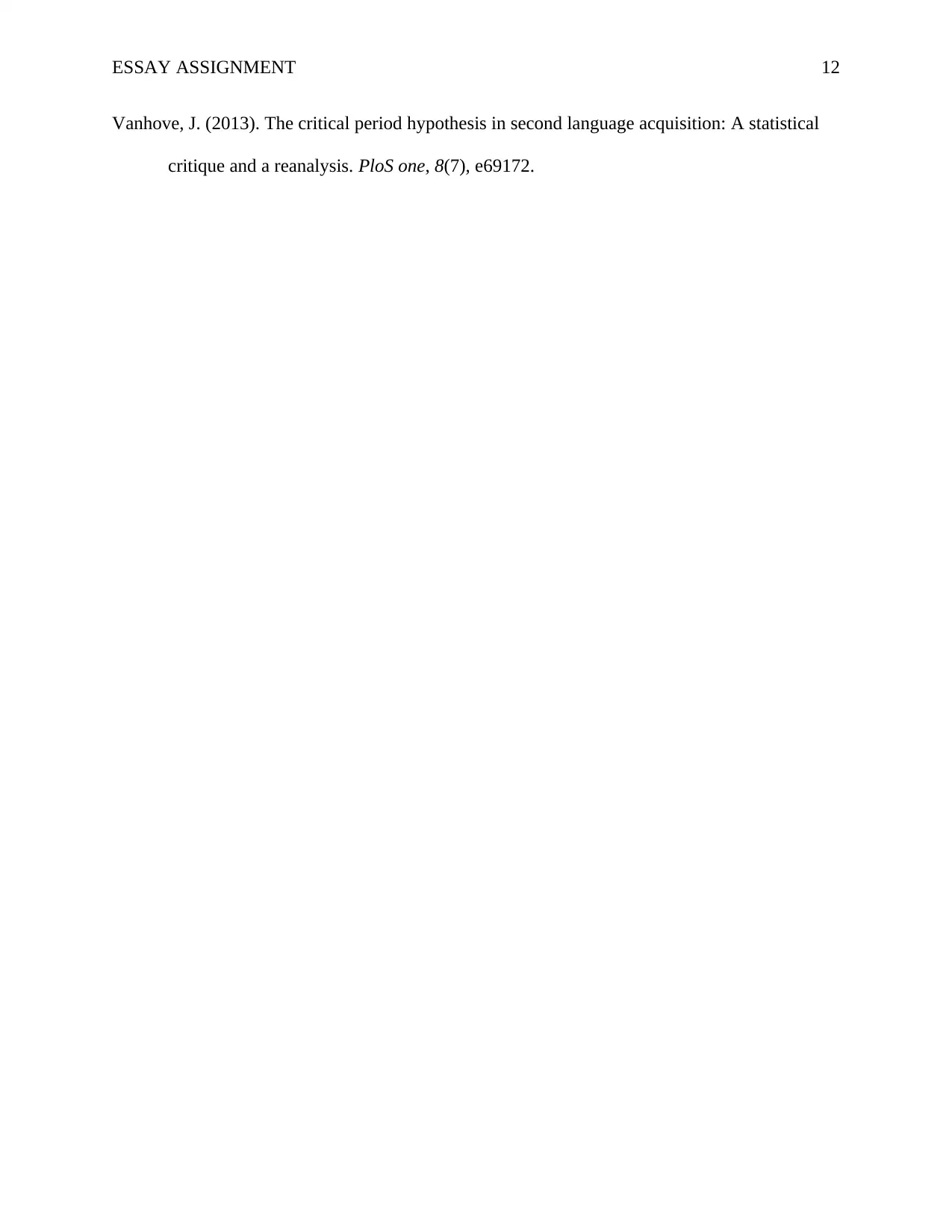
ESSAY ASSIGNMENT 12
Vanhove, J. (2013). The critical period hypothesis in second language acquisition: A statistical
critique and a reanalysis. PloS one, 8(7), e69172.
Vanhove, J. (2013). The critical period hypothesis in second language acquisition: A statistical
critique and a reanalysis. PloS one, 8(7), e69172.
1 out of 12
Your All-in-One AI-Powered Toolkit for Academic Success.
+13062052269
info@desklib.com
Available 24*7 on WhatsApp / Email
![[object Object]](/_next/static/media/star-bottom.7253800d.svg)
Unlock your academic potential
© 2024 | Zucol Services PVT LTD | All rights reserved.
